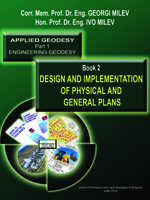ESSENCE, ROLE AND SIGNIFICANCE OF THE SYSTEM OF MONOGRAPHS ON ENGINEERING GEODESY
PPLIED GEODESY - PART 1. ENGINEERING GEODESY - Summary
The project "APPLIED GEODESY" of the authors G. Milev and I. Milev consists of three parts:
- Engineering surveying
- Application of Geodesy in Earth Sciences
- Non-engineering and natural scientific aspects of application of Geodesy
The three parts together treat the versatile application of Geodesy.
Part 1. ENGINEERING SURVEYING consists of three books:
- Basics, systems and technologies in Engineering Surveying – 498 p.
- Design and implementation of physical and general plans – 325 p.
- Construction of linear objects, buildings, facilities, installation of technological equipment. Plans of the built complex objects – due to the large volume, over 1500 pages, it is separated into three books - 3(3.1 – 524 p.), 3(3.2 – 530 p.) и 3(3.3 – 468 p.)
 Design and implementation of physical and
general plans - Book 2
Design and implementation of physical and
general plans - Book 2
Interdisciplinary problems related to the development of territories – development schemes, physical and general plans of a complex of objects – industrial enterprises, airports, etc., are presented along with the role of geodesy and the contribution of land surveyors to their realization. The major emphasis is laid on the technology of design and implementation of regulation plans, general plans and schemes and drafts for vertical planning. Moreover the problems are treated from an interdisciplinary point of view and in the context of the modern possibilities of: digital design, geospatial technologies, using of global navigation satellite systems, electronic systems for data measurement and processing, tracing and monitoring, geoinformation systems, use of modern digital cadastre and others. Along with this the exposition is based and reflects, insofar as possible, the huge current normative and subordinate basis – laws, rules, regulations, instructions, guidelines, etc., and it has become necessary in some cases to cite directly some major aspects of it. However this basis is dynamically developing and its actual state should be always accounted for. A number of real practical examples of physical planning of territories are also included. The long-year work and experience of the authors are also reflected.
Undoubtedly such a broad spectrum of issues cannot be exhaustively considered in all its aspects. A balance has been sought for in the structure of the book and exposition to present the main problems and the emphasis is put on the aspects related more directly to the activities of surveyors in the area of physical planning.
The book is intended primarily for surveyors. However, because of the interdisciplinary nature of the problems and the manner of exposition, it can be very useful for a broad circle of specialists – architects, engineers, lawyers and others working on the issues of physical planning. The benefits may be for the lecturers and all studying these problems, workers in the municipalities and courts, and in the design and construction in this area, owners of land estates and many others.
In digital form, parts of the first three books (including in English) are available in the electronic bookstore biblio.bg (password Георги Милев or tinyurl.com/2p9jyydn).
Such information, and for the last two books 3.2 and 3.3, will be uploaded there soon.